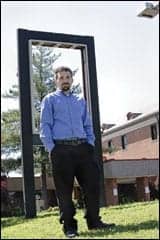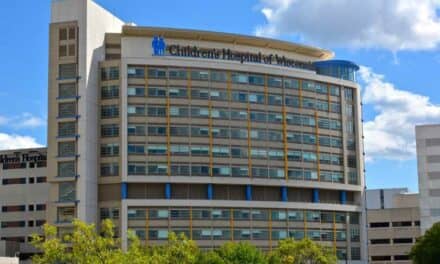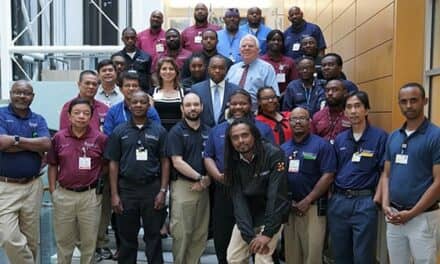As the largest, standalone pediatric hospital between St. Louis and Denver—boasting a whopping 8,500 employees— Kansas City, Mo.-based Children’s Mercy Hospital and Clinics is known for seeing a high patient load. But it is arguably the institution’s clinical engineering team that keeps the medical facility up and running like a well-oiled machine.
Below, five members of Children’s Mercy Hospital and Clinics’ clinical engineering team—Kenneth Ervin, BS, director of biomedical engineering; Kevin Johnson, shop manager; Harold Golden, CBET, BMET III, team lead; Dennis Hammann, CBET, BMET III, team lead; and Joseph Miriani, CBET—sit down with 24×7 Magazine to discuss how the high-stakes pediatric environment often lends to extra stress—and opportunities—and why association membership is critical to success in the HTM field.
24×7 Magazine: What differentiates Children’s Mercy Hospital and Clinics’ clinical engineering team apart from other CE teams?
Joseph Miriani: Given the makeup of our patients, the stress level is a little higher.
Kenneth Ervin: Yes, I agree. The stress level is higher because the acuity of our patients is generally much higher. We see the worst of the worst because we are a pediatric specialty hospital.
24×7: It is no surprise that the HTM field is dealing with staffing shortages, due to retiring professionals and biomed school closures. How does Children’s Mercy Hospital and Clinics ensure a strong pipeline of talent in the CE department?
Dennis Hammann: We partner with local technical schools and routinely pull interns from their programs. And since we have members on their advisory boards, we are involved in adjusting the curriculum of those schools to fit real-life applications. We want to ensure that the students at the technical schools are provided with the appropriate education to prepare them for the workforce.
Ervin: Yes, we are members of the advisory board for one local technical school, so we help guide the material that they teach their BMETs—and we also have an internship program as Dennis mentioned.
Miriani: Plus, we hire a lot from the U.S. military—specifically those who are retiring or finishing their four-year or eight-year terms.
24×7: Can you please discuss a time when Children’s Mercy Hospital and Clinics’ clinical engineering team recently saved the day for other members of the hospital?
Miriani: Yes, on January 26th, we had a routine power generator test that did not go as planned. We lost emergency power to critical areas, such as our 84-bed NICU and 67-bed PICU, which use emergency power to run critical devices such as monitoring equipment. We were able to successfully reroute power to the floors, but it was definitely a stressor. We had to keep our patients safe, and it was a heck of a day.
Harold Golden: This included ventilators, warmers, infusion pumps, and anything plugged into red outlets.
Kevin Johnson: Basically, it was an unfortunate and unexpected result of an automatic power transfer switch installation that did not go as planned—which, in turn, took down two very vital patient care areas at our facility.
Ervin: I also want to add that we save the day every day with what we do—although maybe not to the extent mentioned above. That may be kind of a broad term, but we have components of our medical equipment management service (MEMS department)—which delivers pumps and other medical equipment throughout the hospital. We also have a component of central sterile processing within our department. Their contributions help save lives by providing clean and sterilized equipment to the hospital staff.
24×7: What do you believe are some of the biggest issues currently affecting HTM and why?
Ervin: I think you hit the nail on the head with one of your previous questions: A large majority of the HTM field is older and soon to retire—and, traditionally, we’ve had a small pipeline of newbies coming in. So, at some point, we’re going to have a lack of trained BMETs.
Johnson: Yes, and in addition to a decrease in BMETs in the field, we’ve sadly seen a decrease in participation in some biomed associations.
Ervin: But if I could tell my national peers anything, it’s that being part of their local HTM society is an important component of professional growth. So if they have a chapter around them, I would encourage them to get involved and be active. After all, there’s a lot of support and collaboration between HTM professionals, which can help resolve the problems that plague all of us.
24×7: That’s great advice. How does your team maximize association membership—and what else do you want to tell 24×7 Magazine readers about Children’s Mercy Hospital and Clinics’ CE department?
Harold Golden: For one thing, the Kansas City chapter of the biomed society has a secondary directors meeting separate from our bimonthly meetings, which allows us to share views and compare notes with other hospitals. In one particular instance, we were checking patient-owned equipment prior to use and were able to standardize policies across the metro area by changing our policy to meet local policies.
Ervin: Yes, we use the local HTM society to standardize, benchmark, and collaborate with other HTM professionals to create policies that are standard across the Kansas City metro area. Since we are a specialty pediatric hospital, we are not in competition with our fellow HTM members; this allows us the luxury to collaborate and have healthy HTM meetings without getting into contests with different organizations. It really helps us to focus on biomedical issues.
Also, regarding what I want to tell my fellow 24×7 readers, I want to mention that we are not an island. We utilize a lot of outside services that provide a variety of things for us—and these vendors are also members of our local HTM society.
Johnson: To expand on vendor collaboration, some of us in the shop have worked in the field as vendors. At times, there has been an adversarial mindset between hospitals and vendors; therefore, we foster a positive vendor relationship since we are all in this together to provide working equipment to aid in patient care.
Ervin: Finally, it’s important to note that we are a very large biomed shop with embedded IT personnel and staff who contract within our own department. Because of this, we are able to take on a lot more than purely biomedical equipment.






One of my favorite hospitals!